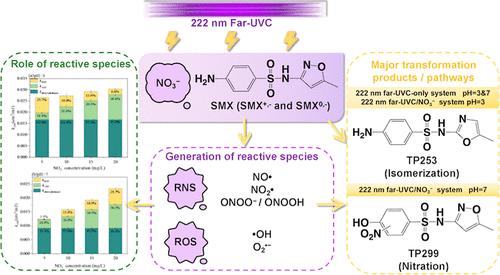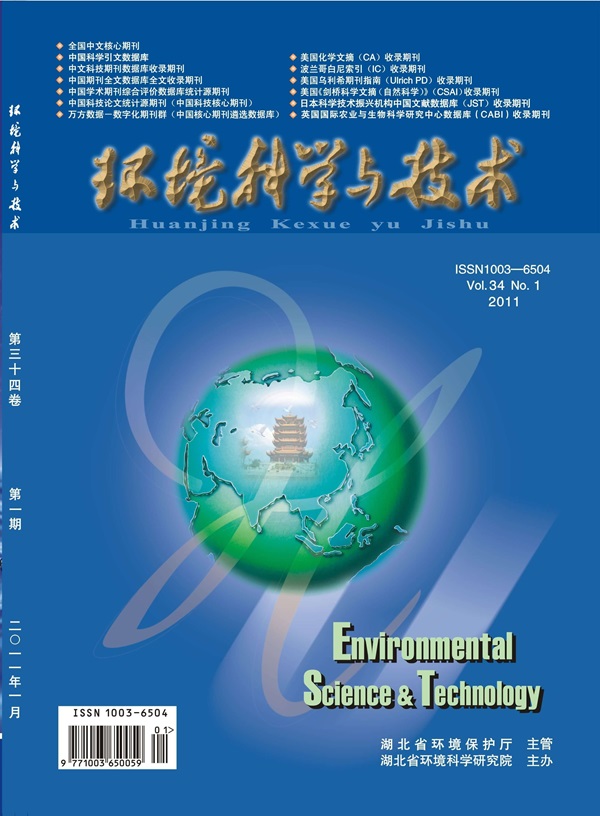Nitrate Enhanced Sulfamethoxazole Degradation by 222 nm Far-UVC Irradiation: Role of Reactive Nitrogen Species
IF 10.8
1区 环境科学与生态学
Q1 ENGINEERING, ENVIRONMENTAL
引用次数: 0
Abstract
The application of 222 nm far-UVC irradiation for degrading organic micropollutants in water shows promise. Nitrate (NO3–), found in nearly all water bodies, can significantly impact the performance of 222 nm far-UVC-driven systems. This work was the first to investigate the effect of NO3– on sulfamethoxazole (SMX) photodegradation at 222 nm, finding that NO3– significantly enhances SMX degradation in different dissociated forms. Besides the hydroxyl radical (•OH), reactive nitrogen species (RNS) also played important roles in SMX degradation. With increasing NO3– concentration, the RNS contribution to SMX degradation decreased from 25.7 to 8.6% at pH 3 but increased from 1.5 to 24.7% at pH 7, since the deprotonated SMX with electron-rich groups reacted more easily with RNS. The transformation mechanisms of SMX involving isomerization, bond cleavage, hydroxylation, nitrosation, and nitration processes were proposed. 15N isotope labeling experiments showed that the RNS-induced nitrated products even became the major products of SMX in the 222 nm far-UVC/NO3– system at pH 7 and exhibited a higher toxicity than SMX itself. Further research is necessary to avoid or eliminate these toxic byproducts. This study provides valuable insights for guiding the utilization of 222 nm far-UVC for treating antibiotics in NO3–-containing water.

222 纳米远紫外辐照在降解水中有机微污染物方面的应用前景广阔。几乎所有水体中都存在硝酸盐(NO3-),它会严重影响 222 纳米远紫外驱动系统的性能。这项工作首次研究了 NO3- 在 222 纳米波长下对磺胺甲噁唑(SMX)光降解的影响,发现 NO3- 能显著增强 SMX 在不同离解形式下的降解。除了羟基自由基(-OH),活性氮物种(RNS)在 SMX 降解中也发挥了重要作用。随着 NO3- 浓度的增加,RNS 对 SMX 降解的贡献率在 pH 值为 3 时从 25.7% 降至 8.6%,而在 pH 值为 7 时则从 1.5% 增加至 24.7%,这是因为具有富电子基团的去质子化 SMX 更容易与 RNS 发生反应。提出了 SMX 的转化机制,包括异构化、键裂解、羟基化、亚硝基化和硝化过程。15N 同位素标记实验表明,在 pH 值为 7 的 222 nm 远紫外/NO3-系统中,RNS 诱导的硝化产物甚至成为 SMX 的主要产物,其毒性高于 SMX 本身。为避免或消除这些有毒副产品,有必要开展进一步的研究。这项研究为指导利用 222 纳米远紫外线处理含 NO3- 的水中的抗生素提供了宝贵的见解。
本文章由计算机程序翻译,如有差异,请以英文原文为准。
求助全文
约1分钟内获得全文
求助全文
来源期刊

环境科学与技术
环境科学-工程:环境
CiteScore
17.50
自引率
9.60%
发文量
12359
审稿时长
2.8 months
期刊介绍:
Environmental Science & Technology (ES&T) is a co-sponsored academic and technical magazine by the Hubei Provincial Environmental Protection Bureau and the Hubei Provincial Academy of Environmental Sciences.
Environmental Science & Technology (ES&T) holds the status of Chinese core journals, scientific papers source journals of China, Chinese Science Citation Database source journals, and Chinese Academic Journal Comprehensive Evaluation Database source journals. This publication focuses on the academic field of environmental protection, featuring articles related to environmental protection and technical advancements.
文献相关原料
| 公司名称 | 产品信息 | 采购帮参考价格 |
|---|
 求助内容:
求助内容: 应助结果提醒方式:
应助结果提醒方式:


